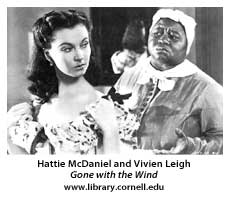Her career was defined by the culture of post civil war America. The limitations on a black person in film should have stopped her cold. Hattie McDaniel was not an ordinary person. She appeared in over 84 films. She was a performer on stage, on the radio and television. Her legacy to history is that of a warm and engaging actress giving each role her own original touch. She brought to the silver screen strengths of warmth, humor, intelligence, and assertiveness. She opened doors to all black actors – not bad for the daughter of a former slave.
Born in Kansas. Hattie learned gospel singing from her dad. Hattie was one of two black children in an otherwise all white elementary class. Teachers and students noted her talents as a singer. By high school she had lead parts in school plays. Her dad started the Henry McDaniel Minstrel Show, 1910 two brothers joined the group. Hattie quit school to join the tour. She later toured with the Melody Hounds. When the depression hit, work for vaudeville acts crashed. Times were hard. Hattie went to work as a bathroom attendant at Sam Pick’s Club in Milwaukee. The club hired whites only. Some of the patrons heard her singing in the bathroom. They convinced the owner to hire her as a singer. She performed there for a year, and then headed to Los Angeles. Her brother found her a small role on a local station, The Optimistic Do-Nuts. Before long she was the main attraction, Hi-Hat Hattie. Hattie was the first black woman to be broadcast over American radio – on the air with Professor George Morrison’s Negro Orchestra, Denver, Colorado (1915).

Hattie landed her first film role in The Golden West, 1932 (not credited) playing the part of Mammy Lou, a maid. A lot of her film parts were not credited. The pay was low. Hattie had to use the back door at the studio. She was not invited to social events. She was not invited to premiers – she had to work as a maid to keep food on the table while building her career. She learned a southern accent that she used in her stereotyped southern maid parts. Her parts continued to get larger. She had five more minor roles in films. In 1934 she got a larger part, Aunt Dilsey, in Judge Priest starring Will Rogers. In 1935 she got the part of Becky, a servant, in The Little Colonel, starring Shirley Temple. Her roles put her at odds with some of the black community. They were upset with Hollywood stereotyping. Hattie said “I would rather play the part of a maid in the movies than be one in real life.” The roles available during the 30s and 40s for large black women were for maids, cooks or a mammy. In 1935 she played the part of a grumbling maid, Malena Burns. In the dinner scene (Alice Adams, starring Katherine Hepburn) she makes it clear that she has little use for her employer’s pretensions. The scene was the only bright spot in the movie. In The Mad Miss Manton, 1938, she had the role of Hilda, Melsa’s maid. Hilda tells off her socialite employer, Melsa Manton, and her snobby friends.
The path leads her to the most famous part of her career, Mammy, in Gone with the Wind, 1939, earning a thousand a week. Clark Gable and Hattie were friends. He played a trick on Hattie during a shoot. In the Bonnie Blue birth scene, he put brandy in the decanter instead of iced tea. Gone with the Wind was a national sensation, premiering at Loew’s Grand Theater, Atlanta, Georgia. Hattie was not invited to the premier. Clark Gable threatened to boycott the premier. He relented when Hattie convinced him to go.
The original book to be handed out at the premier had her picture on the back cover. The studio realized that because the opening was in Atlanta, they could not use it. They had it reprinted with a blank back cover. That would not work. They had it printed a third time with Hattie on half the back cover and Clark Gable on the other half. The first two prints were never distributed. They slowly disappeared from the studio. The really valuable book is the one with the picture of Hattie on the back cover – few survived. In 1940 Hattie got an Oscar for best supporting actress in Gone with the Wind. She was the first black to win an Oscar. She was the first black to attend the Academy Awards as a guest. There had been lots of blacks at the Oscars before that… all serving food.
Hattie died in 1952 of breast cancer. Her last wish… to be buried in Hollywood Forever Cemetery… was denied. In 1999, 47 years after her death, a pink and gray granite monument was put up at the cemetery. Hattie left her Oscar to the Howard University but it was lost during the race riots there in 1960. Gone forever. In the 73 years of the Academy Awards, only 2.2% of the Oscars have gone to black actors. Hattie was the first.
